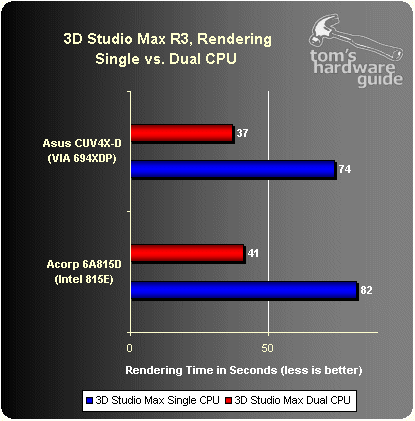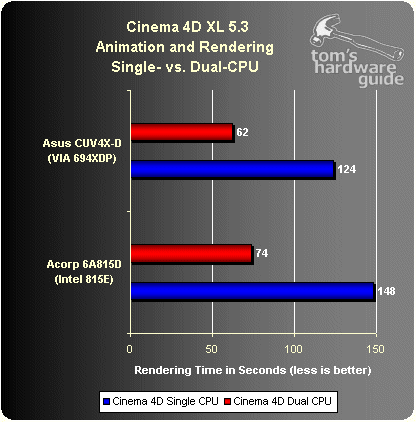Turbo Drive: Two Dual Boards with 2000 MHz
Benchmark Results And Discussion
Our test platforms are equipped with top-notch components promising high performance. Both candidates use two Pentium III/1000 which are supplemented by 256 MB of fast memory at 133 MHz (CL2) and a sinfully expensive Nvidia Quadro2 Pro graphics card (Elsa Gloria III, approx. $1100). However, this advantage in speed is only of great importance using selected applications such as 3D Studio Max or Cinema 4D. Otherwise, the deployment of a dual processor system is less noticeable than expected in daily usage. Although the results of Sysmark 2000 show slightly higher results during dual operation, the increase in speed remains under 10 percent.
Rendering Performance: 3D Studio Max R3

While rendering under 3D Studio Max, the second CPU can use its full capacity on either board. The render time of the ktx_race.max scene is cut exactly in half due to the second CPU. Surprisingly, in comparing both chipsets, the VIA Apollo Pro133A comes in before the Intel 815E. This fact is most certainly due to the beta state of the Acorp board, meaning that this board is not yet performing to its full capacity.
Animation And Rendering: Cinema 4D XL 5.3

Similar results are revealed using the Cinema 4D XL high-end program: The calculation of the test film sequence can be cut in half using a second CPU. Again, the Acorp using the Intel 815E chipset finishes after the Asus CUV4X-D using VIA Apollo Pro 133A. The reason for this result lies again in the Beta state of the Acorp board.
Stay on the Cutting Edge
Join the experts who read Tom's Hardware for the inside track on enthusiast PC tech news — and have for over 25 years. We'll send breaking news and in-depth reviews of CPUs, GPUs, AI, maker hardware and more straight to your inbox.
Current page: Benchmark Results And Discussion
Prev Page Overclocking Functions Next Page Office Performance: BAPCo Sysmark 2000Most Popular

